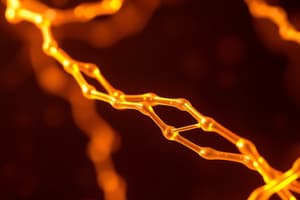Podcast
Questions and Answers
What characteristic of optically active conducting polymers is highlighted as a major focus in studies?
What characteristic of optically active conducting polymers is highlighted as a major focus in studies?
- Distinct helicity (correct)
- High molecular weight
- Mechanical flexibility
- Thermal conductivity
Which polymer was reported to self-assemble into a highly ordered fibrous structure?
Which polymer was reported to self-assemble into a highly ordered fibrous structure?
- Polythiophene
- Polyaniline
- Poly(azomethine) (correct)
- Polyacetylene
What influence does chiral nature have on polymer formation?
What influence does chiral nature have on polymer formation?
- Enhances biodegradability
- Increases resistivity
- Affects higher-order structures (correct)
- Decreases thermal stability
What was notably observed in the studies of Benzotriazole–thiophene copolymers with chiral side chains?
What was notably observed in the studies of Benzotriazole–thiophene copolymers with chiral side chains?
What was a finding regarding the electrochemical properties of chiral polypyrrole?
What was a finding regarding the electrochemical properties of chiral polypyrrole?
What morphological characteristics emerged from processing polythiophenes with chiral thioether side chains?
What morphological characteristics emerged from processing polythiophenes with chiral thioether side chains?
In what application did polyanilines demonstrate their chiral conformation's influence?
In what application did polyanilines demonstrate their chiral conformation's influence?
What kind of nanostructures were created by manipulating chiral poly(arylacetylene)?
What kind of nanostructures were created by manipulating chiral poly(arylacetylene)?
Which analysis method revealed that optically active polymers had more ordered morphologies?
Which analysis method revealed that optically active polymers had more ordered morphologies?
What is a significant drawback of introducing large side chains to polyacetylene?
What is a significant drawback of introducing large side chains to polyacetylene?
Which backbone material is NOT mentioned as a focus for conducting polymers with chiral side chains?
Which backbone material is NOT mentioned as a focus for conducting polymers with chiral side chains?
In which application area do conducting polymers show great potential due to their dynamic properties?
In which application area do conducting polymers show great potential due to their dynamic properties?
How does chirality affect the responsiveness of an organic thin-film transistor in sensing applications?
How does chirality affect the responsiveness of an organic thin-film transistor in sensing applications?
What relationship is highlighted in conducting polymers with chiral side groups?
What relationship is highlighted in conducting polymers with chiral side groups?
What is one of the potential advantages of chirality in conducting polymers?
What is one of the potential advantages of chirality in conducting polymers?
What property is NOT associated with the dynamic characteristics of conducting polymers?
What property is NOT associated with the dynamic characteristics of conducting polymers?
Which of the following statements about bulk material properties in conducting polymers is true?
Which of the following statements about bulk material properties in conducting polymers is true?
Which chiral side chain example features stereochemistry–property relationships?
Which chiral side chain example features stereochemistry–property relationships?
What impact do chiral side groups have on the conductivity and charge transport of conducting polymers?
What impact do chiral side groups have on the conductivity and charge transport of conducting polymers?
Flashcards are hidden until you start studying
Study Notes
Conducting Polymers with Chiral Side Chains
- Polyacetylene is the first conducting polymer reported to contain a chiral side chain.
- Large side chains in polyacetylene disrupt the conjugative pathway, limiting application in organic semiconductors.
- Focus shifted to polythiophenes, polypyrroles, and polyanilines, which maintain conductivity with bulky substituents.
Applications and Properties
- Conducting polymers are prominent in organic optoelectronics and hold potential in bioelectronics for sensing applications.
- They exhibit dynamic properties like electrochromism, solvatochromism, thermochromism, and switchable redox chemistry, often enhanced by chirality.
- Chiral side groups in organic thin-film transistors improve responsiveness in sensing applications.
Morphology and Chirality
- The conductivity and charge transport in conducting polymers are affected by their morphology; chirality may enhance solid-state ordering.
- Optically active poly(azomethine) forms highly ordered fibrous structures, unlike its racemic counterpart.
- Varying processing conditions for chiral polythiophenes correlate morphological characteristics with circular dichroism (CD) signals.
Self-Assembly and Higher-Order Structures
- Conjugated chiral small molecules promote supramolecular self-assembly into higher-order macromolecular structures.
- Chiral polyanilines induced by chiral counterions produce ordered conducting microfibers, nanofibers, and hexagonal superlattices.
- Chiral poly(arylacetylene) can create various chiral nanostructures through metal complexation, while aromatic ester polymers form chiral nanoparticles.
Electrochemical Properties and Stereochemistry
- The electrochemical properties of chiral polypyrrole vary based on the stereochemical configuration of the side chain.
- Benzotriazole-thiophene copolymers with chiral side chains are compared with racemic analogues, revealing unique behaviors despite similar optical solid-state properties.
- Benzo-thiadiazole copolymers show that optically active versions have more ordered morphologies and tighter chain packing as confirmed by X-ray scattering.
Research Implications
- Differences in stereochemistry can lead to varying polymer properties, underscoring the need for further investigations in the field of optically active conducting polymers.
Studying That Suits You
Use AI to generate personalized quizzes and flashcards to suit your learning preferences.




